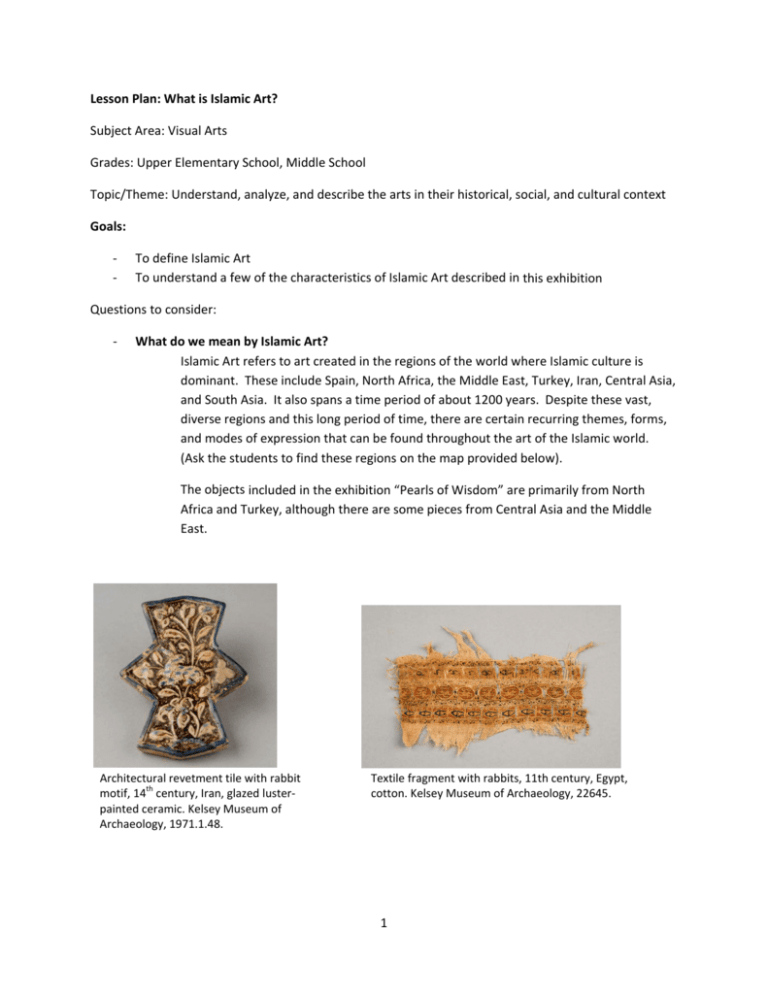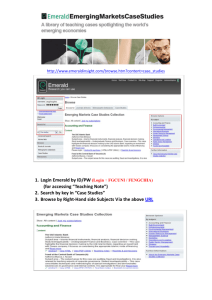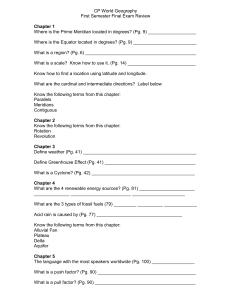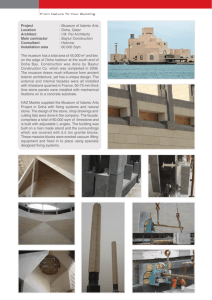1 Lesson Plan: What is Islamic Art? Subject Area: Visual Arts Grades
advertisement

Lesson Plan: What is Islamic Art? Subject Area: Visual Arts Grades: Upper Elementary School, Middle School Topic/Theme: Understand, analyze, and describe the arts in their historical, social, and cultural context Goals: ‐ ‐ To define Islamic Art To understand a few of the characteristics of Islamic Art described in this exhibition Questions to consider: ‐ What do we mean by Islamic Art? Islamic Art refers to art created in the regions of the world where Islamic culture is dominant. These include Spain, North Africa, the Middle East, Turkey, Iran, Central Asia, and South Asia. It also spans a time period of about 1200 years. Despite these vast, diverse regions and this long period of time, there are certain recurring themes, forms, and modes of expression that can be found throughout the art of the Islamic world. (Ask the students to find these regions on the map provided below). The objects included in the exhibition “Pearls of Wisdom” are primarily from North Africa and Turkey, although there are some pieces from Central Asia and the Middle East. Architectural revetment tile with rabbit motif, 14th century, Iran, glazed luster‐ painted ceramic. Kelsey Museum of Archaeology, 1971.1.48. Textile fragment with rabbits, 11th century, Egypt, cotton. Kelsey Museum of Archaeology, 22645. 1 ‐ ‐ an you identify the similarities in these objects? W What about th he differencees? Ca What are som W e of these co ommon themes, forms and d modes of eexpression? Religio on: Although not all Islamic art is religioous, the religiion of Islam h has an importtant orate buildinggs or influen nce in Islamicc art. Passage es from the Q Qur’an may bee used to deco clothin ng. The charaacteristic use of highly styllized and absttract patternss is in part related to the fact that figu ures of animals and peoplee are generallly not used in n the Qur’an o or to decoraate mosques. However, figgures can be found in both secular and d religious Islaamic art, especially painttings, textiles, and tilewor k. Tiraz textile fragmeent, 10th centuury, Egypt, undyyed linen and dyed silk. Kelseyy Museum of Archaaeology, 22520 0. Magic bowl with attached prayer tablets, 0th century, Iraan, brass. probaably 19th or 20 Histo oric Scientific In nstrument Collection, Specia l Collections, Hatche er Graduate Lib brary, GL7. 2 Everyday Beauty: Creating high quality objects that are beautiful, well‐made, and useful is another key characteristic of Islamic art. Islamic art typically was not solely made for the sake of making art. Most pieces are useful in addition to being beautiful, whether it is a water filter or a piece of architecture. This ornamentation includes the use of calligraphy, geometric patterns, vegetal (also called arabesque) patterns, and figures. It is also characteristic that the artist’s personal ideas or feelings are not easily seen in the art works. Spindle whorls, 9th–10th centuries, Fustat (medieval Cairo), Egypt, incised bone. Kelsey Museum of Archaeology, 1969.2.60 3 Mamluk pen box (qalamdan), 14th century, Egypt, brass inlaid with gold and silver. Kelsey Museum of Archaeology, 28802. Play and Protection: In addition to being beautiful, the patterns found in Islamic art can also be used to challenge the viewer to solve a visual puzzle. Figures can be used in this way as well, including images of fish placed at the bottom of a drinking cup to tease the drinker. Some of these visual puzzles may be used to protect. One example is a geometric pattern on an amulet with a letter placed within each of the shapes. Each letter can be used to spell the names of important religious figures whose protection the wearer can invoke. Additionally, geometry and geometric patterns are a common characteristic of Islamic art. Math and science were important disciplines in the medieval Islamic world. Base of a bowl decorated with two fish, 14th century, Fustat (medieval Cairo), Egypt, glazed ceramic. Kelsey Museum of Archaeology, 1968.3.52. 4 Amulet with magic square and the Seven Sleepers of Ephesus, 20th century, Cairo, Egypt, lead. Kelsey Museum of Archaeology, 80681. Media Metaphors: In Islamic art, an object’s shape, patterns, or material may mimic another, such as a glass bottle made to look like cut crystal or a ceramic vessel decorated with raised patterns resembling jewels. These media metaphors may be intended to make the viewer look twice or may be to make luxurious‐looking items more available. One such luxury item would be imported goods. Trade and interconnections with other cultures is another key feature of Islamic art. The influence of other cultures on Islamic art can be found in many objects, such as pottery made to look like Chinese wares. Likewise, the influence of Islamic art can be found in the art of other cultures, such as in the arts and architecture of Venice. Ceramic vessel fragment studded with gemlike motifs, 13th–15th centuries, Egypt, clay with stamped and applied decoration. Kelsey Museum of Archaeology, 1969.2.21. 5 Molar flask (unguentarium), 9th–10th centuries, Egypt, blown and cut glass. Kelsey Museum of Archaeology, 1970.3.1011. Illuminations: This term refers to the embellishment of manuscripts with geometric and vegetal designs, but it also can have a deeper meaning. First of all, such decorations often incorporated metallic and polychrome paints that give a glow to the page when light reflects off of the paint. Second, the text itself illuminates the reader by shedding light on the subject it discusses. And third, for those who might not be able to read the text, the decoration indicates the importance of the text and sometimes even provides a visual clue as to what the text is about. Illuminated double‐page opening of the Qur’an, dated AH 1032/1623 CE, Ottoman lands, ink and gold on paper. Special Collections, Hatcher Graduate Library, Isl. Ms. 167. The Prophet Muhammad’s death, Fuzuli (1495– 1556), Hadiqat al‐Su‘ada (Garden of the Blessed), text dated AH 1006/1598 CE, possibly Ottoman Baghdad, ink, pigment, and gold on paper. Special Collections, Hatcher Graduate Library, Isl. Ms. 386, page 137. 6 Classroom Activity: Design an exhibition brochure. Using the online exhibition (and the exhibition at the Kelsey Museum if you can visit), have the students each select 3 objects. Create a trifold brochure about the exhibition. Include a descriptive paragraph of what is Islamic art, a short description (2‐3 sentences) of each selected object, and a conclusion about what they learned at the exhibition or why they think others should visit the exhibition. Have students present their brochures to the class and discuss the pieces they chose and how they reflect the characteristics of Islamic art. Common Core Standards: ART.VA.IV.K – 5 Standard 4: Understand, analyze, and describe the arts in their historical, social, and cultural contexts National Learning Standards: Visual Arts NA‐VA.K‐12.4 Understanding the Visual Arts in Relation to History and Cultures 7 8









